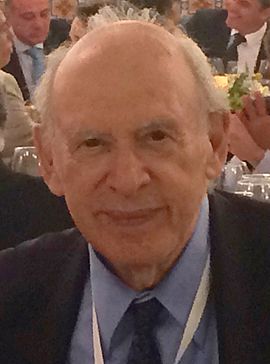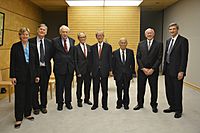Jerome Isaac Friedman facts for kids
Jerome Isaac Friedman is a famous American physicist. He is known for his important work that helped us understand the tiny particles inside atoms. In 1990, he won the Nobel Prize in Physics along with two other scientists, Henry Kendall and Richard Taylor. They discovered that protons, which are parts of atoms, are made up of even smaller pieces called quarks. This discovery was a big step forward in understanding how everything in the universe is built.
Quick facts for kids
Jerome Isaac Friedman
|
|
|---|---|

Friedman in 2016
|
|
| Born | March 28, 1930 Chicago, Illinois, U.S.
|
| Alma mater | University of Chicago |
| Known for | Experimental proof of quarks |
| Spouse(s) | Tania Letetsky-Baranovsky (m. 1956; 4 children) |
| Awards | President's Medal of the IOP (2000) Nobel Prize in Physics (1990) |
| Scientific career | |
| Fields | Physics |
| Institutions | MIT |
| Doctoral advisor | Enrico Fermi |
Contents
Jerome Friedman's Life and Discoveries
Early Life and Education
Jerome Isaac Friedman was born in Chicago, Illinois, on March 28, 1930. His parents had moved to the U.S. from Russia. As a young person, Jerome was very good at art. However, he became fascinated by physics after reading a book by Albert Einstein about relativity.
He decided to study physics instead of art. He went to the University of Chicago. There, he worked with a famous scientist named Enrico Fermi. Friedman earned his Ph.D. in physics in 1956. A few years later, in 1960, he joined the physics team at the Massachusetts Institute of Technology (MIT).
Discovering Quarks
In the late 1960s, Jerome Friedman worked on very important experiments. He teamed up with Henry W. Kendall and Richard E. Taylor. They used a special machine called a particle accelerator at the Stanford Linear Accelerator Center in California.
Their experiments involved shooting tiny particles called electrons at protons. Protons are found in the center of every atom. Before their work, scientists thought protons were solid, simple particles. But Friedman and his team found something surprising.
When the electrons hit the protons, they bounced off in unexpected ways. This showed that protons were not solid. Instead, they had smaller, harder pieces inside them. These tiny pieces were later named "quarks." This discovery was the first real proof that quarks exist.
For this groundbreaking work, Friedman, Kendall, and Taylor were awarded the Nobel Prize in Physics in 1990. Their findings were crucial for developing the "quark model," which helps us understand how matter is made up of these fundamental particles.
Later Career and Advocacy
After his Nobel Prize, Jerome Friedman continued his work at MIT. He became an "institute professor," which is a very high honor. He has also been involved in important discussions about science and its role in the world.
For example, in 2008, he joined 19 other Nobel Prize winners in physics. They wrote a letter to the U.S. President. They asked for more funding for basic science research. They believed it was important to support scientific discoveries.
Honors and Awards
Jerome Friedman has received many honors for his contributions to science.
 Grand Cordon of the Order of the Rising Sun (2016)
Grand Cordon of the Order of the Rising Sun (2016)- Member of the American Philosophical Society (2002)
- Member of the National Academy of Sciences (1992)
- Golden Plate Award of the American Academy of Achievement (1991)
- Member of the American Academy of Arts and Sciences (1980)
See also
 In Spanish: Jerome Isaac Friedman para niños
In Spanish: Jerome Isaac Friedman para niños
- List of Jewish Nobel laureates


